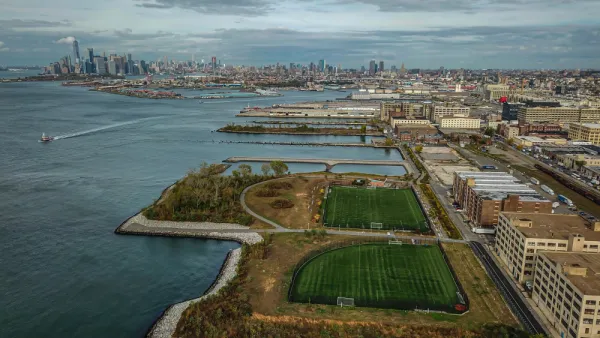Improving streets in Sunset Park by removing cobblestones and aging train tracks has created a controversy between historic preservation and the need for safe bike and walking facilities and other streetscape improvements.
The streetscape improvement plan, which includes removing "swaths of the neighborhood’s cobblestone streets and railways," is included in New York City Economic Development Corporation's (NYCEDC) "estimated $37 million Sunset Park Infrastructure Project" that was the subject of a Brooklyn community board meeting on April 8, report Jaime DeJesus and Meaghan McGoldrick for the Brooklyn Daily Eagle.
That has railroad buffs and neighborhood boosters concerned about erasing part of the neighborhood’s history.
“The presence of cobblestone in the maritime area is iconic,” said Sunset Park resident and founder of Friends of Sunset Park Maria Roca, who was hoping to see a recovery or reuse plan that would “keep the cobblestones as part of the decorative mix.”
“They should definitely preserve the cobblestones and rails for several reasons,” said Bob Diamond, president of the Brooklyn Historic Railroad Association. “It’s part of the history of the area. Industry City was primarily serviced by rails, and pulling it out is like gutting the history of the neighborhood.”
Industry City is a $1 billion waterfront redevelopment of what used to be called Bush Terminal, "a historic intermodal shipping, warehousing, and manufacturing complex and the largest multi-tenant industrial property in the United States," according to Wikipedia.
Need for bike and pedestrian safety
"The Sunset Park Infrastructure Project is the result of a 2009 study, said Thomas Colavecchio, technical director for AKRF Environment, Planning and Engineering Consultants, the project’s lead designer," add DeJesus and McGoldrick.
“It was determined that there was a severe deficiency in infrastructure,” he said, “so the goal of the project was to make it safer for both pedestrians and vehicles, to improve the uneven road service and, overall, to promote businesses in the area," said Thomas Colavecchio, technical director for AKRF Environment, Planning and Engineering Consultants, the project’s lead designer.
“It’s very difficult for pedestrians to walk in this area,” he said, calling the current streets “decrepit.” [See Google maps image photo (jpg) in article.]
Colin Mixson, reporting for the Brooklyn Paper, observed that "[t]he roughly block-long bike lane — which will be installed alongside an expanded sidewalk, and separated from cars by a line of trees — will not link with any existing paths for cyclists, although the plan is to eventually connect it to the Brooklyn Greenway Initiative."
The Brooklyn Eagle article includes 35 slides [Scribd document] showing maps, photos, images and renderings by ARKF, which led the environmental review for the replacement of the Tappan Zee bridge, now named for former Gov. Mario Cuomo; Phase 1 of the Second Avenue Subway, and is now working on Phase 2 (96th Street to 125th Street).
Not all the train tracks will be removed though, as New York New Jersey Rail travels through the area to access the South Brooklyn Marine Terminal, transporting freight cars from Jersey City via barge, and train traffic is anticipated to increase, thanks to another NYEDC infrastructure investment.
Another significant part of the streetscape improvement plan includes planting more than 120 new streets trees in the project area, including Industry City and the South Brooklyn Marine Terminal.
Correspondent's note: While unable to locate NYCEDC's Sunset Park Infrastructure Project, here is there Sunset Park Vision Plan.
Related:
-
Is a New Cobblestone a Better Cobblestone? March 31, 2013In Brooklyn's Dumbo neighborhood, NYCDOT is looking to replace the area's historic cobblestones with artificially aged new ones to improve accessibility and bike-friendliness.
FULL STORY: City plans to remove rails and cobblestones along Sunset Park waterfront

Analysis: Cybertruck Fatality Rate Far Exceeds That of Ford Pinto
The Tesla Cybertruck was recalled seven times last year.

National Parks Layoffs Will Cause Communities to Lose Billions
Thousands of essential park workers were laid off this week, just before the busy spring break season.

Retro-silient?: America’s First “Eco-burb,” The Woodlands Turns 50
A master-planned community north of Houston offers lessons on green infrastructure and resilient design, but falls short of its founder’s lofty affordability and walkability goals.

Test News Post 1
This is a summary

Analysis: Cybertruck Fatality Rate Far Exceeds That of Ford Pinto
The Tesla Cybertruck was recalled seven times last year.

Test News Headline 46
Test for the image on the front page.
Urban Design for Planners 1: Software Tools
This six-course series explores essential urban design concepts using open source software and equips planners with the tools they need to participate fully in the urban design process.
Planning for Universal Design
Learn the tools for implementing Universal Design in planning regulations.
EMC Planning Group, Inc.
Planetizen
Planetizen
Mpact (formerly Rail~Volution)
Great Falls Development Authority, Inc.
HUDs Office of Policy Development and Research
NYU Wagner Graduate School of Public Service


























